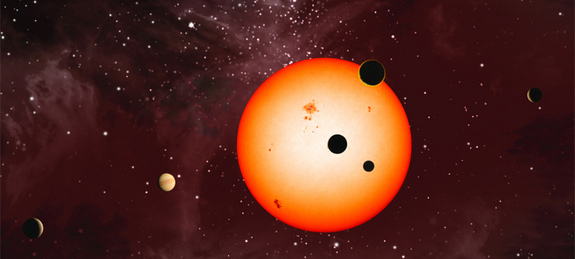
Artist's illustration of extrasolar planets discovered around the star Kepler 11 by NASA's Kepler Space Telescope (Nature).
Astronomers have discovered an alien solar system in which six planets are orbiting a sunlike star, with five of the newfound worlds in close-knit configuration. Few stars have been observed with planetary arrangements like our solar system, making this a compelling find. The newfound exoplanet system was sighted by astronomers using NASA's planet-hunting Kepler space observatory. The smallest of the new alien planets is about 2.3 times the mass of Earth. None of the extrasolar planets are inside the so-called "habitable zone" -- orbits where liquid water could exist on their surfaces, scientists said. Astronomers made the serendipitous find after poring over Kepler's observations of the changing brightness of the system's parent star -- called Kepler-11 -- as the orbiting planets passed in front of the star. More>>
We used to have Miles O'Brien, This Week in Space
- California UFOs appeared to be having "fun"
 (Feb. 1, 2011) A California witness driving north on Interstate-5 near the Arena Blvd. exit at 8:00 p.m. on Jan. 31, 2011 reports watching four bright, multi-colored lights 100 feet off of the ground, according to Feb. 1 testimony from the Mutual UFO Network (MUFON) witness reporting database.
(Feb. 1, 2011) A California witness driving north on Interstate-5 near the Arena Blvd. exit at 8:00 p.m. on Jan. 31, 2011 reports watching four bright, multi-colored lights 100 feet off of the ground, according to Feb. 1 testimony from the Mutual UFO Network (MUFON) witness reporting database.
(NASA TV, Feb. 2, 2011) NASA's Kepler Mission has discovered 54 planet candidates that orbit in the habitable zone of their host star; this so-called "Goldilocks" region is "not too hot or too cold, but just right" for the possible existence of liquid water on the surface of a planet. Four of those candidates are near Earth-sized planets in orbit around small, cool stars. The findings, discussed at a news conference held Feb. 2 at NASA Headquarters in Washington, are based on data collected by the space telescope between May and September, 2009. Ground-based observatories will be used this spring and summer to help determine if these candidates can be validated as planets.




















































































































































































































































No comments:
Post a Comment